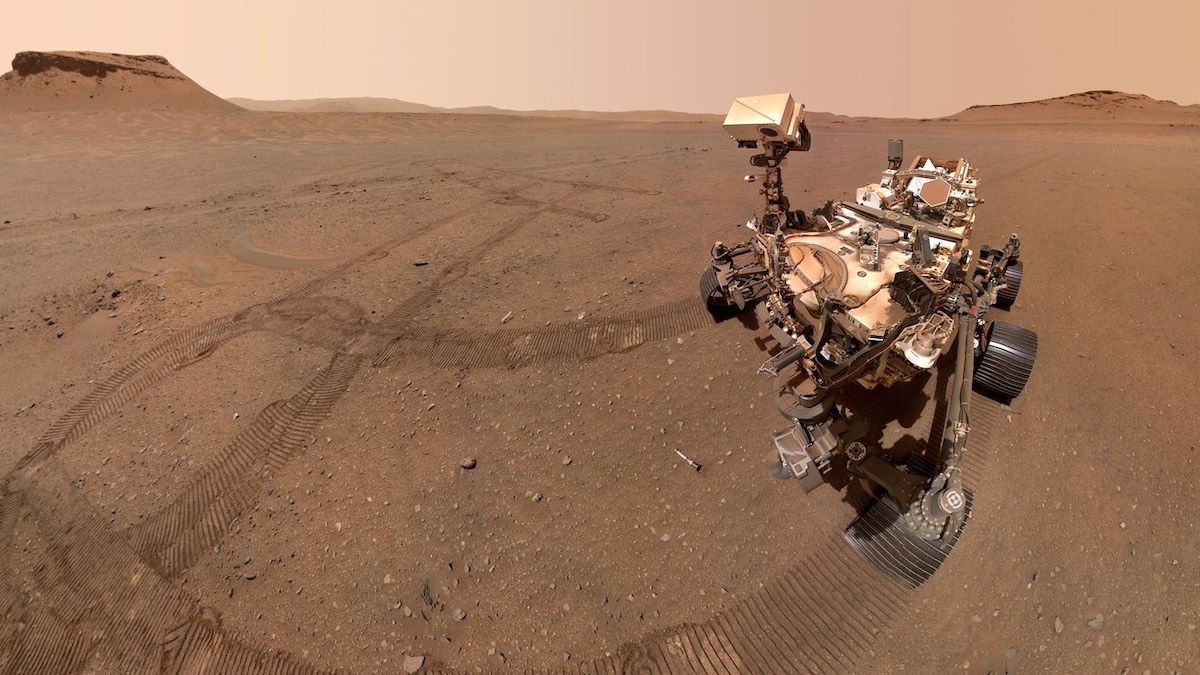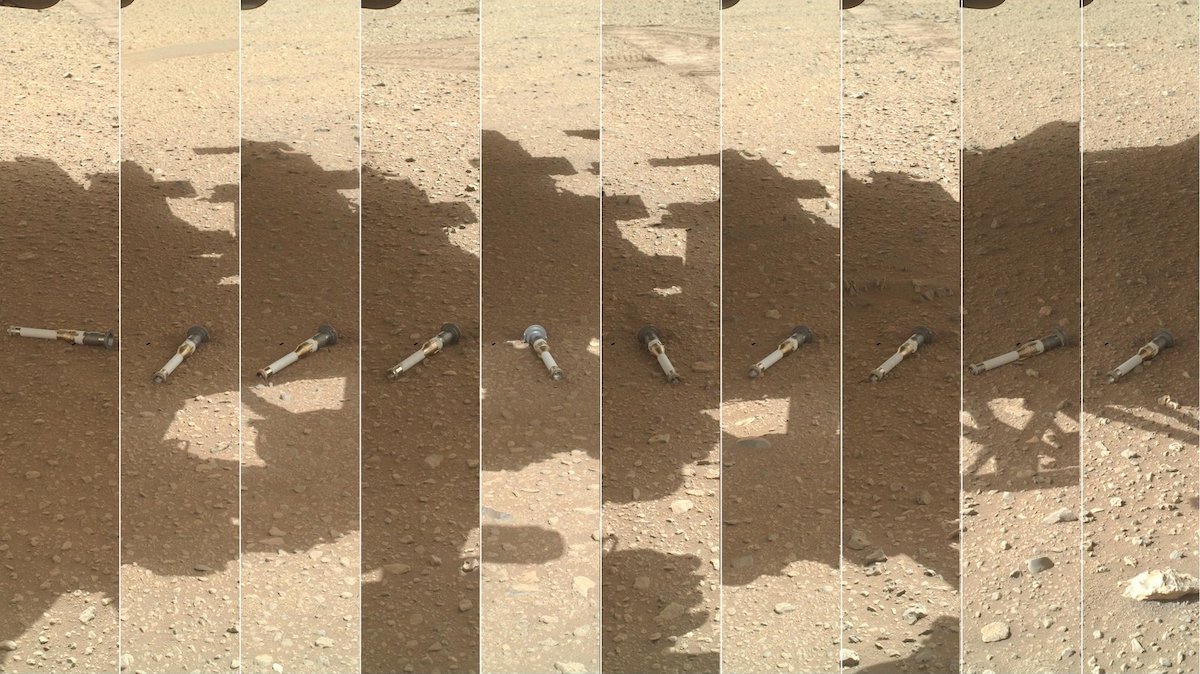
NASA’s Perseverance rover on Mars has cooly notched up another significant first by creating the first ever storage depot on another world for Martian soil samples. But if the rover’s mission goes to plan and it continues to operate as scheduled, the cached samples could be left on the Martian surface forever.
That’s because they are the backup duplicates of a set retained on-board by the Perseverance rover, which would be the prime target for the future collection and return to Earth mission.
Having completed its task of depositing 10 sample tubes in a defined area on the surface of Mars with flying colors, the plucky rover has now moved on to the next phase of its mission.
This is a new science campaign at a location named “Curvilinear Unit,” essentially a Martian sandbar made of sediment that eons ago was deposited in a bend in one of the Jezero Crater’s inflowing river channels. The science team believes the Curvilinear Unit will be an excellent location to hunt for intriguing outcrops of sandstone and perhaps even mudstone, and to get a glimpse at the geological processes beyond the walls of the crater itself.
Perseverance is part of NASA’s Mars 2020 mission, and it landed on the Red Planet at Jezero Crater almost exactly two years ago on Feb. 18, 2021.
It has already proved a huge success after launching the tiny Mars helicopter named Ingenuity, which became the first vehicle to fly independently on another planet. On completion of its initial 30-day technology demonstration flight, Ingenuity continues in its operations demo phase.
Meanwhile, the 10 sample tubes, capturing what scientists hope will be an amazing variety of Martian geology, will remain on the surface of Mars at the depot dubbed “Three Forks” awaiting possible collection in years to come before a return trip to Earth.
Confirmation that Perseverance had successfully dropped the 10th and final tube planned for the depot was received at around 5 p.m. PST (8 p.m. EST) on Sunday, Jan. 29, by mission controllers at the NASA’s Jet Propulsion Laboratory (JPL) in Southern California.

Shown, from left, are “Malay,” “Mageik,” “Crosswind Lake,” “Roubion,” “Coulettes,” “Montdenier,” “Bearwallow,” “Skyland,” “Atsah,” and “Amalik.” Deposited from Dec. 21, 2022, to Jan. 28, 2023, these samples make up the sample depot Perseverance built at “Three Forks,” a location within Mars’ Jezero Crater. Credit: NASA/JPL-Caltech/MSSS
This major milestone for operations on another planet involved precision planning and navigation to ensure the tubes could be safely recovered in the future by the NASA-ESA Mars Sample Return mission, which aims to bring Mars samples back to Earth for closer study.
Throughout its science campaign up to now, the rover had been taking a pair of samples from rocks that mission scientists deemed “scientifically significant.” One sample from each pair now sits in the carefully arranged depot in the Three Forks region of Jezero Crater.
The depot samples serve as a backup set while the other half remain inside Perseverance, which would be the primary means to convey samples to a Sample Retrieval Lander as part of the return to Earth campaign.
Mission scientists believe the igneous and sedimentary rock cores will provide an excellent cross section of the geologic processes that took place in Jezero shortly after the crater’s formation, which is believed to be almost four billion years ago.
The rover also deposited an atmospheric sample and what’s called a “witness” tube, which is used to determine if samples being collected might be contaminated with materials that traveled with the rover from Earth.
The titanium tubes were deposited on the surface in an intricate zigzag pattern, with each sample about 15 to 50 feet (5 to 15 meters) apart from one another to facilitate safe recovery.
Adding painstaking time to the depot-creation process, the team needed to precisely map the location of each 7-inch-long (18.6-centimeter) tube and glove (adapter) combination so that the samples could be found even if covered with Martian dust. The depot is on flat ground near the base of the raised, fan-shaped ancient river delta that formed long ago when a river flowed into a lake there.
“The surface of Mars here is like a pool table — really boring,” says NASA chief Mars scientist Mike Meyer. “But this will make it easier for a future mission to land and recover the store should it need to.”
According to mission scientist Meenakshi Wadhwa of Arizona State University, the Three Forks depot builds robustness into NASA’s Mars sample return plans. “The depot is critical because it guarantees that a scientifically high-value sample collection will be available for Earth return in case Perseverance is unable to deliver for any reason,” she explained.
Describing the depot plan as “a really big deal,” Lori Glaze, NASA’s director of planetary science, says: “Scientists believe the depot samples offer a good range of analytical opportunities. The volcanic rocks will tell them about the age of Jezero Crater and the broader geological history of Mars.
“The sedimentary rocks are the ones that will have the greatest interest in trying to identify traces of ancient biology. Perseverance drilled these from the remnant delta deposits in Jezero. It’s the kind of feature that might just have trapped evidence of past microbial organisms.”
She added that the question of finding evidence of life on Mars could only be addressed using sophisticated techniques that were available in laboratories on Earth. “We can do a lot in situ with our remote-sensing instruments, but we can’t take all of our laboratory equipment and all of our human expertise to the surface of Mars.
“So we bring the samples back here, and then we can not only use all of our state-of-the-art equipment, but we’ll have those samples for decades and we can come up with new ideas to test the samples that we haven’t even dreamed of yet.”
